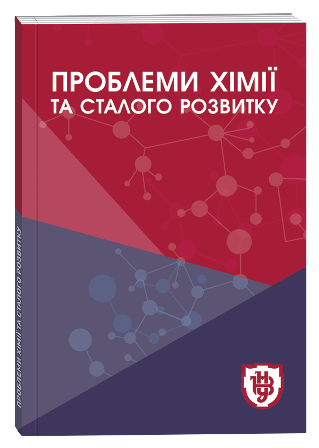GLAS FORMATION IN THE QUASI-TERNARY SYSTEMS AІ 2S–ВIVS2–СV 2S3 (АI – CU, AG; ВIV – GE, SN, СV – AS, SB)
DOI:
https://doi.org/10.32782/pcsd-2021-4-1Keywords:
quasi-ternary systems, phase diagram, chalcogenides, glass formation, X-ray phase analysisAbstract
The boundaries of the glass formation areas of quasiternary systems AІ 2S–ВIVS2–СV 2S3 (АI – Cu, Ag; ВIV – Ge, Sn, СV – As, Sb) have been established by based on the results of X-ray phase analysis. Maximum synthesis temperature was 1100 K, followed by quenching of the ampoules in 25% a solution of sodium chloride with crushed ice. The obtained glasses have been dark gray, yellow-red color monolithic alloys. There are continuous bands of glass formation on the sides GeS2–СV 2S3 in the studied germanium-containing systems АI 2S–GеS2–СV 2S3. The main factor is the tendency of GeS2, As2S3 and Sb2S3 to the glass formation. The content of 0 – 55 мол.% Ag2S have been obtained in the vitreous state from the cross section Ag2S–GeS2. In the quasi-binary system Ag2S – As2S3 there is a region of glass formation in the 0–70 mol.% Ag2S. The maximum content of the modifier Cu2S that could be introduced while preserving the glassy state is 10 and 15 mol.% in the systems Cu2S–GеS2–As(Sb)2S3. The maximum content of the Ag2S that is part of the glass in the systems Cu2S–GеS2–As(Sb)2S3 state is 10 and 15 mol.%. The areas of glass formation have been much smaller compared to similar germanium-containing in the statecontaining systems of the glassformation area, which is associated with the strengthening of the ionic component of the chemical bond by changing GeS2 to SnS2. We observe only two areas of glass formation in quasi-triple systems Сu(Ag)2S–SnS2–Sb2S3 which are on the side SnS2–Sb2S3: one in the area 17–23 mol.% Sb2S3, the maximum content of Cu2S and Ag2S is 3 and 2 mol.%; the other – 66–83 mol.% Sb2S3, the maximum content of Cu2S and Ag2S is 12 and 4 mol.%. In the system Cu2S–SnS2–As2S3 the region of glass formation state is 76–100 mol.% As2S3, the maximum content of Cu2S is 12 mol.%. In the Ag2S – SnS2 – As2S3 system, on the cross section of Ag2S–As2S3, the region of glass formation state is 0–75 mol.% Ag2S. On the cross section of SnS2–As2S3 the region of glass formation state is 78–100 mol.% As2S3.
References
Шпотюк М.В. Фізичні особливості радіаційно-структурної модифікації ковалентно-сіткового скла As–S : дис. … док. фіз.-мат. наук : 01.04.07. Львів, 2018. 345 с.
Бабанлы М.Б., Юсибов Ю.А., Абишев В.Т. Трехкомпонентные халькогениды на основе меди и серебра. Баку : БГУ, 1993. 342 с.
Cho J.Y., Shi X., Salvador J.R., Meisner G.P., Yang J. et al. Thermoelectric properties and investigations of low thermal conductivity in Ga-doped Cu2GeSe3. Physical Review B. 2011. Vol. 84. № 8. Doi : 10.1103/PhysRevB.84.085207
Marcano G., Bracho D.B., Rincon C., Perez G.S., Nieves L. On the temperature dependence of the electrical and optical properties of Cu2GeSe3. Journal of Applied Physics. 2000. Vol. 88. P. 822–828.
Виноградова Г.З. Стеклообразование и фазовые равновесия в халькогенидных системах. Москва : Наука, 1984. 238 с.
Кевшин А.Г. Особливості структури халькогенідних стекол на базі GeX2 (X=S, Se). Фізика і хімія твердого тіла. 2014. Т. 15. № 4. С. 682–688.
Борисова З.У., Бычков Е.А., Тверьянович Ю.С. Взаимодействие металлов с халькогенидными стеклами : монография. Ленинград, 1991. 252 с.
Роусон Г. Неорганические стеклообразующие системы. Москва : Мир, 1970. 270 с.
Паюк О., Ліщинський І., Стронський О., Криськов Ц., Губанова А., Прібилова Г., Влочек М. Властивості стекол As2S3 легованих марганцем: калориметричні дослідження та Раманівська спектроскопія. Фізика і хімія твердого тіла. 2011. Т. 12. № 3. С. 594–597.
Flaschen S.S., Pearson A.D., Northover W.R. Low-melting inorganic glasses with high melt fluidities below 400°. J. Amer. Ceram. Soc. 1959. Vol. 42. № 9. P. 450.
Kamitsos E.I., Kapoutsis J.A., Chryssikos G.D., Taillades G., Pradel A., Ribes M. Structure and Optical Conductivity of Silver Thiogermanate Glasses. J. Solid State Chem. 1994. Vol. 112. № 2. P. 255–261. Doi : 10.1006/jssc.1994.1301.
El Mkami H., Deroide B., Zanchetta J.V., Rumori P., Abidi N. Electron paramagnetic resonance study of Mn2+ and Cu2+ spin probes in (Ag2S)x(GeS2)1–x glasses. J. Non-Cryst. Solids. 1996. Vol. 208. № 1–2. P. 21–28. Doi: 10.1016/S0022-3093(96)00509-1.
Борисова З.У. Халькогенидные полупроводниковые стекла. Ленинград : Ленингр. ун-т, 1983. 344 с.
Климович О.С., Змій О.Ф., Олексеюк І.Д. Фазові рівноваги та склоутворення в системі Cu2Se – SnSe2 – As2Se3. Наук вісн. СНУ імені Лесі Українки. Хімічні науки. 2013. № 23. С. 89–94.
Климович О.С., Змій О.Ф., Олексеюк І.Д. Cклоутворення в системі Cu2Se – GeSe2 –As2Se3. Наук. вісн. ВДУ імені Лесі Українки. Хімічні науки. 2007. № 15. С. 14–18.
Фунтиков В.А. К вопросу о строении стёкол и физико-химическом анализе стеклообразных систем. Физика и химия стекла. 1996. Вып. 22. № 3. С. 279–285.
Ковач С.К., Кохан A.П., Ворошилов Ю.В. Электрохимическое поведение Ag8GeS6 и Ag8GeSe6. Укр. хим. журн. 1993. Вып. 59. № 4. С. 396–398.
Кохан О.П. Взаємодія в системах Ag2X–BIVX2 (BIV–Si, Ge, Sn; X–S, Se) і властивості сполук ׃ автореф. дис. … канд. хім. наук : 02.00.01. Ужгород, 1996. 21 с.
Liu Jun, Videau J. J., Tanguy B., Portier J., Reau J. M. Investigation on glass in the As−Ag−S system. Mater. Res. Bull. 1988. Vol. 23. P. 1315–1320.






